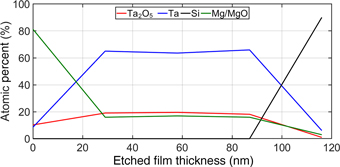Crossref Citations
This article has been cited by the following publications. This list is generated based on data provided by
Crossref.
Zhao, Mingyue
Pfeifenberger, Manuel J.
and
Kiener, Daniel
2020.
Open-cell tungsten nanofoams: Chloride ion induced structure modification and mechanical behavior.
Results in Physics,
Vol. 17,
Issue. ,
p.
103062.
Zhao, Mingyue
Issa, Inas
Pfeifenberger, Manuel J.
Wurmshuber, Michael
and
Kiener, Daniel
2020.
Tailoring ultra-strong nanocrystalline tungsten nanofoams by reverse phase dissolution.
Acta Materialia,
Vol. 182,
Issue. ,
p.
215.
Welborn, Samuel S.
van der Meer, Sven
Corsi, John S.
de Hosson, Jeff Th. M.
and
Detsi, Eric
2021.
Using X-Ray Scattering to Elucidate the Microstructural Instability of 3D Bicontinuous Nanoporous Metal Scaffolds for Use in an Aperiodic 3D Tricontinuous Conductor–Insulator–Conductor Nanocapacitor.
ACS Applied Materials & Interfaces,
Vol. 13,
Issue. 10,
p.
11721.
Fu, Jintao
Corsi, John S.
Welborn, Samuel S.
Basile, Victoria
Wang, Lin
Ng, Alexander K.
and
Detsi, Eric
2021.
Eco-friendly Synthesis of Nanoporous Magnesium by Air-Free Electrolytic Dealloying with Recovery of Sacrificial Elements for Energy Conversion and Storage Applications.
ACS Sustainable Chemistry & Engineering,
Vol. 9,
Issue. 7,
p.
2762.
Welborn, Samuel S.
Corsi, John S.
Wang, Lin
Lee, Asaph
Fu, Jintao
and
Detsi, Eric
2021.
Effects of side reactions on the kinetics of nanoporous gold formation revealed by real-time X-ray scattering during electrolytic dealloying.
Journal of Materials Chemistry A,
Vol. 9,
Issue. 35,
p.
19994.
Vizoso, Daniel
Kosmidou, Maria
Balk, T. John
Hattar, Khalid
Deo, Chaitanya
and
Dingreville, Rémi
2021.
Size-dependent radiation damage mechanisms in nanowires and nanoporous structures.
Acta Materialia,
Vol. 215,
Issue. ,
p.
117018.
Guo, Xueyi
Zhang, Chunxi
Tian, Qinghua
and
Yu, Dawei
2021.
Liquid metals dealloying as a general approach for the selective extraction of metals and the fabrication of nanoporous metals: A review.
Materials Today Communications,
Vol. 26,
Issue. ,
p.
102007.
Welborn, Samuel S.
Simafranca, Alexander
Wang, Zeyu
Wei, Heng
and
Detsi, Eric
2021.
Chelation-mediated synthesis of nanoporous gold at near-neutral pH and room temperature by free corrosion dealloying of gold-copper alloy driven by oxygen reduction.
Scripta Materialia,
Vol. 200,
Issue. ,
p.
113901.
Fu, Jintao
Welborn, Samuel S.
and
Detsi, Eric
2022.
Dealloyed Air- and Water-Sensitive Nanoporous Metals and Metalloids for Emerging Energy Applications.
ACS Applied Energy Materials,
Vol. 5,
Issue. 6,
p.
6516.
Yu, Lin-Chieh
Clark, Charles
Liu, Xiaoyang
Ronne, Arthur
Layne, Bobby
Halstenberg, Phillip
Camino, Fernando
Nykypanchuk, Dmytro
Zhong, Hui
Ge, Mingyuan
Lee, Wah-Keat
Ghose, Sanjit
Dai, Sheng
Xiao, Xianghui
Wishart, James F.
and
Chen-Wiegart, Yu-chen Karen
2022.
Evolution of micro-pores in Ni–Cr alloys via molten salt dealloying.
Scientific Reports,
Vol. 12,
Issue. 1,
Bai, Huanhuan
Maxwell, Tyler L.
Kordesch, Martin E.
and
Balk, T. John
2023.
Physical vapor deposition and thermally induced faceting of tungsten nanoparticles.
Materials Characterization,
Vol. 198,
Issue. ,
p.
112724.
Nikulin, Artem
Grosu, Yaroslav
Dauvergne, Jean-Luc
Ortuondo, Asier
and
del Barrio, Elena Palomo
2023.
Physical dealloying for two-phase heat transfer applications: Pool boiling case.
International Communications in Heat and Mass Transfer,
Vol. 146,
Issue. ,
p.
106913.
Scandura, Gabriele
Kumari, Priyanka
Palmisano, Giovanni
Karanikolos, Georgios N.
Orwa, Julius
and
Dumée, Ludovic F.
2023.
Nanoporous Dealloyed Metal Materials Processing and Applications─A Review.
Industrial & Engineering Chemistry Research,
Vol. 62,
Issue. 4,
p.
1736.
Liu, Xiaotao
Zhang, Xiaomeng
Kosmidou, Maria
Detisch, Michael
and
Balk, Thomas
2023.
Synthesizing Nanoporous Stainless Steel Films via Vacuum Thermal Dealloying.
Metals,
Vol. 13,
Issue. 7,
p.
1255.
Zhang, Yongchao
Mi, Changwen
and
Gou, Xiaofan
2024.
Surface curvature-dependent strength analysis of three-dimensional nanoporous metals.
Acta Mechanica Sinica,
Vol. 40,
Issue. 1,
Vazquez von Bibow, N.
Millán, E.N.
and
Ruestes, C.J.
2024.
Topological changes and deformation mechanisms of nanoporous Ta under compression.
Computational Materials Science,
Vol. 236,
Issue. ,
p.
112884.
Das Gupta, Tibra
and
Balk, Thomas John
2024.
Inhibited Surface Diffusion in Nanoporous Multi-Principal Element Alloy Thin Films Prepared by Vacuum Thermal Dealloying.
Metals,
Vol. 14,
Issue. 3,
p.
289.





